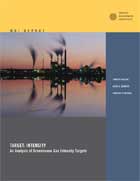An Analysis of Greenhouse Gas Intensity Targets
 WASHINGTON D.C., USA – A new report from the World Resources Institute finds that although greenhouse gas intensity targets are often dismissed as being environmentally lax or deceptive, they could be useful policy instruments for furthering significant and real commitments to reducing greenhouse gases. This is an important conclusion for Canada, as the federal government plans to introduce short-term intensity based targets in 2010 before setting emissions caps between 2020-2025.
WASHINGTON D.C., USA – A new report from the World Resources Institute finds that although greenhouse gas intensity targets are often dismissed as being environmentally lax or deceptive, they could be useful policy instruments for furthering significant and real commitments to reducing greenhouse gases. This is an important conclusion for Canada, as the federal government plans to introduce short-term intensity based targets in 2010 before setting emissions caps between 2020-2025. Target: Intensity. An Analysis of Greenhouse Gas Intensity Targets explores the underlying indicators, rationales, real-world applications, and implementation issues related to intensity targets.
Intensity based targets specify emissions reductions relative to productivity or economic output, such as per barrel of oil or per dollar of GDP. By contrast, absolute emissions targets specify reductions measured in metric tons, relative to an historical baseline.
This paper explores the use of GHG intensity targets as tools to help nations achieve real reductions in GHG emissions. It looks at examples of how intensity targets have sometimes masqueraded as real reductions, and it presents examples of how, properly set and enforced, intensity can result in real and meaningful reductions.
It argues that intensity targets should be part of the toolkit available to governments exploring reduction policies. Intensity targets are especially pertinent to developing countries. Correctly set, they can lead to absolute reductions in GHG emissions by creating incentives for energy efficiency and the development of clean energy technologies. Intensity targets can also accommodate the need for economic growth -growth that we must accept and embrace - especially in the poorest of nations. Intensity targets can help that growth to occur efficiently and sustainably.
The full report can be downloaded by clicking here.
You can return to the main Market News page, or press the Back button on your browser.

